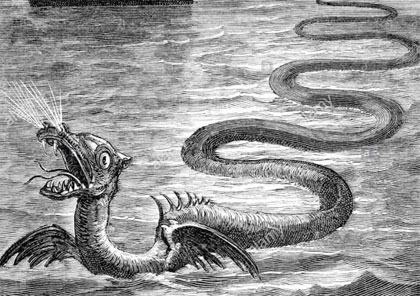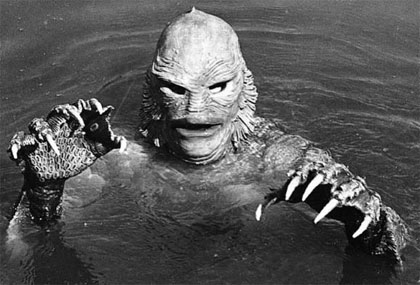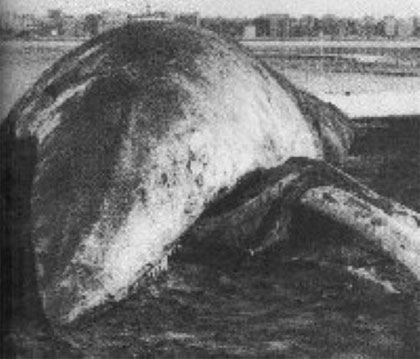
Mysterious Cases of Sea Monster Carcasses Washed up on Shore
Brent Swancer September 27, 2021
The Holy Grail of cryptozoology has always been that of actual, hard physical evidence. With all of the mystery monsters supposedly prowling about on the periphery of our understanding and with very little to go on other than eyewitness accounts and blurry photos, there really needs to be something more, a body. On occasion, there have been those cases in which such evidence has apparently turned up, and with regards to lake and sea monsters there have been plenty of tales of these beasts washing up on shore, only to disappear back into the murky realms beyond our reach.
In 1883, a man known only as “Mr. Hoad” was taking a stroll along a rural place called Brungle Creek, in New South Wales, Australia, when right after a flood he stumbled cross something very bizarre, indeed. According to the witness, he found there on the shore a weird creature measuring around 30 feet in length, with a lobster-like curved tail and in the place of where a head should be merely what looked like an elephant’s trunk. At the time, newspaper reports were making it out to be the body of a creature from Australian lore called a “Bunyip,” and the author Charles Fort would say of the discovery in his book Lo!:
Remains of a strange animal, teleported to this earth from Mars or the moon — very likely, or not so likely — found on a bank of a stream in Australia. See the Adelaide Observer, Sept. 15, 1883 — that Mr. Hoad, of Adelaide, had found on a bank of Brungle Creek, a headless trunk of a pig-like animal, with an appendage that curved inward, like the tail of a lobster.
Making matters even more confusing is that there are also reports that another man by the name of Henry Wilkinson, who also reportedly came across the “headless trunk of a strange animal,” with a pig-like appearance and a “terminal appendage that curls inward, and resembles the tail of a huge lobster,” also along the shore of Brungle Creek. What is sometimes called “Hoad’s Monster” was claimed by the newspapers to be sent to the Sydney Museum for further scientific analysis, but there is no further word on it after that, and no known physical evidence remaining. It is very likely that this was just a sensationalized newspaper account with nothing behind it, and making it even murkier is that subsequent retellings of the story over the years have added details such as hair covering the body or flippers, but we will probably never know for sure.
Another report from the 19th century comes from the crew of the British steamer the Emu, which made a stop at the south Pacific atoll known as Suwarrow Island on their way to Sydney, Australia. While they were there, natives excitedly told them of a type of large and mysterious creature they had seen off the coast, which they called the “Devil Fish,” and they even claimed that one had washed ashore. They were led to the carcass and saw that it was 60-feet long, covered with brownish hair, and had the head of a horse, with two formidable tusks jutting from its lower jaw. It was absolutely massive, weighing about 70 tons, so they were unable to move it, but the Emu crew secured as many of the remains as they could, including the beast’s skull. It is unknown what became of these remains, but the most common explanation was that they had misidentified a beaked whale. What did they really find out there at that island? Who knows?
 From 1930 we have a report that is every bit as peculiar. In November of that year, there was allegedly discovered a “prehistoric animal or reptile” on Alaska’s remote and forbidding Glacier Island. The creature in question was reported as having a body about 20 feet long, a 16-foot-long tail, and a 6-foot-long head with a long snout, and at the time the discovery was widely reported in publications such as New York Times, and it was intriguing enough to get a man named W. J. McDonald to launch an expedition to investigate these claims. He would take a team out to the glacier and supposedly find the creature in question, which he described as having “a long tail and tapering head, much like a dinosaur,” “horse-like flesh,” and an elephantine head with a long trunk of some sort. Unfortunately, the carcass would wash back out to sea not too long after to be lost. What did they find out there? One idea is that it was nothing more than a misidentified carcass of a wooly mammoth, but considering the body is long gone, we will never know.
From 1930 we have a report that is every bit as peculiar. In November of that year, there was allegedly discovered a “prehistoric animal or reptile” on Alaska’s remote and forbidding Glacier Island. The creature in question was reported as having a body about 20 feet long, a 16-foot-long tail, and a 6-foot-long head with a long snout, and at the time the discovery was widely reported in publications such as New York Times, and it was intriguing enough to get a man named W. J. McDonald to launch an expedition to investigate these claims. He would take a team out to the glacier and supposedly find the creature in question, which he described as having “a long tail and tapering head, much like a dinosaur,” “horse-like flesh,” and an elephantine head with a long trunk of some sort. Unfortunately, the carcass would wash back out to sea not too long after to be lost. What did they find out there? One idea is that it was nothing more than a misidentified carcass of a wooly mammoth, but considering the body is long gone, we will never know.
Moving along to the years of World War II we have a few cases. One revolves around a Japanese surveillance team stationed on the picturesque Kei Islands of Indonesia, who reported coming across strange merbeings described as being around 150cm tall, with webbed hands and feet, and carp-like mouths filled with spiny teeth. The heads were adorned with prominent spines and the faces were somewhat human-like in appearance. Baffled soldiers sometimes encountered these curious beasts frolicking and splashing about in the water as well as occasionally even coming up on beaches. The native population of the islands knew of these creatures and called them the Orang Ikan, or “man fish.”
The sergeant of the team, Taro Horibe, was invited to come look at the dead body of one such creature at the village chief’s house. The perplexed sergeant described the dead creature as being around 160 cm long, with red-brown, shoulder length hair, and spines along the neck. The face was said to have a mix of human and ape-like features such as a low, broad nose and prominent brow. The lipless mouth was wide like that of a fish, and filled with tiny, needle-like teeth. The creature’s fingers and toes were long and webbed. Horibe was deeply affected by what he had seen, and actively sought zoologists from his home country to investigate upon his return. Ultimately, he was unsuccessful in finding anyone willing to do so, and as such it is unlikely we will ever know what the Orang Ikan truly was.
 Another account from the Second World War takes us to the shores of Gourock, Scotland, where in 1942 a very bizarre beast was found washed ashore. One council officer named Charles Rankin arrived at the scene to measure and study the creature, finding it to be no known animal that he knew of. It was reportedly 27 feet long, with a broad tail, a long neck ending in a small, flat head with pronounced brow ridges that tapered to a point and an oversized maw full of intimidating sharp teeth. The body had four flippers and was covered in 6-inch long, quill-like bristles, and Rankin had the overall impression that it was reptilian in nature. The whole of it was decomposing, with the spinal column exposed and the air permeated with a rancid stench, so the carcass was not long after disposed of, its ultimate resting place unknown. Making this case even more frustrating was that it was apparently in a classified, high-security area during war time, and so Rankin was not allowed to take any photographs of it.
Another account from the Second World War takes us to the shores of Gourock, Scotland, where in 1942 a very bizarre beast was found washed ashore. One council officer named Charles Rankin arrived at the scene to measure and study the creature, finding it to be no known animal that he knew of. It was reportedly 27 feet long, with a broad tail, a long neck ending in a small, flat head with pronounced brow ridges that tapered to a point and an oversized maw full of intimidating sharp teeth. The body had four flippers and was covered in 6-inch long, quill-like bristles, and Rankin had the overall impression that it was reptilian in nature. The whole of it was decomposing, with the spinal column exposed and the air permeated with a rancid stench, so the carcass was not long after disposed of, its ultimate resting place unknown. Making this case even more frustrating was that it was apparently in a classified, high-security area during war time, and so Rankin was not allowed to take any photographs of it.
In 1950 there was a rather strange case from Egypt, where in January of that year a storm passed through the Gulf of Suez to leave a massive, whale-sized carcass behind. The decomposing remains were like a whale in some respects, including its general shape and the blow hole on its head, but it was anomalous in that it had two massive tusks extending out from its mouth, unlike any known marine mammal, and it also had no discernible eyes, as well as an array of cilia like appendages circling its mouth. At the time, experts couldn’t classify it, and without modern forensic techniques all we really have to go on is a single grainy black and white photo of it. What has come to be known as the Ataka carcass has been debated and discussed ever since, with many holding it up as evidence of an undiscovered marine animal, while skeptics say it is just a weird looking decomposed whale carcass, with the jaw bones detached and splayed out through deterioration to merely seem like tusks. However, this was not the conclusion that scientists at the time came to, and it remains unsolved.
 The Ataka carcass
The Ataka carcass
Moving along to the 60s, in March of 1969 an enormous mystery carcass was found on a beach in Tecoluta, Mexico. The creature was huge, estimated as weighing 35 tons, somewhat serpentine in shape, covered with “hard jointed armor,” and had a giant 10-foot-long horn protruding from its head. At the time it was described as “no creature known to man,” and scientists could not identify it. The creature was left on the beach as an attraction for some time, after it was disposed of and its bones put in the Marine Museum in Tecoluta. In recent years it has been speculated that it was just a decomposing narwhale or finback whale, but it has never been properly identified. The following year, in November of 1970, a curious creature washed up at Mann Hill Beach, in Massachusetts. Whatever it was, it was described as being very strange indeed, 20 feet long and looking like “a camel without legs,” with a long neck, small head, and two prominent front flippers. Although it has in later years been written off as nothing more than the misidentification of a decomposing basking shark, it is not known for sure, and the Mann Hill carcass has become a rather famous case among washed up sea monster carcasses.
In the 1980s, there is the case of a strange animal washed up on the shores of the African nation of Gambia. On June 12, 1983, amateur naturalist Owen Burnham was taking a stroll along the seashore at a resort area called Bungalow Beach when he allegedly came across a 14-foot-long creature with brownish skin, a pale underbelly, short neck, a massive 5-foot-long head filled with 80 sharp, conical teeth, four flippers, and no dorsal fin. Curiously, it did not have a blowhole, but rather prominent nostrils, meaning it was not a whale or other known cetacean. The carcass was in nearly pristine condition, having decomposed little, and the only damage being a torn rear flipper. Burnham knew that this was a potentially groundbreaking discovery, but sadly the locals soon came in to chop the body up, sell the head as a souvenir, and bury the carcass in the sand. Cryptozoologists have since tried to locate the corpse to no avail. Ideas on what it could have been range from an undiscovered species of whale, to a relic specimen of a presumed extinct prehistoric marine creature such as a short-necked species of plesiosaur, zeuglodon, or mosasaur, or on the other end of the spectrum just a misidentified known species. We’ll probably never know for sure. In the end, we will probably never know for sure on any of these cases, and they remain mysteries and frustrating lost chances at physical evidence of sea monsters.
MU*























